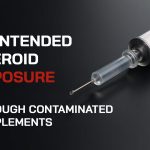Your basket is currently empty!
Category:
Combat Sports Legends Accused of Steroid Use: The Impact on Legacy and Fair Play
November 16th, 2024 by anabolicpointThe world of combat sports, known for its high-intensity performances and brutal competition, has long been intertwined with the use of performance-enhancing drugs (PEDs), particularly anabolic steroids. While athletes in these sports push their physical limits to gain a competitive edge, the controversial and often secretive nature of steroid use has led to some of the most famous names in combat sports facing allegations of steroid abuse. These accusations have had a profound impact not only on the athletes themselves but also on the sports they represent, leading to questions of fairness, ethics, and the true meaning of athletic achievement.
In this article, we will delve into the stories of combat sports legends who have been accused or caught using steroids, the implications these allegations have had on their careers and the broader combat sports community, and the challenges in proving or disproving such accusations. We will also explore the ethical and legal aspects of steroid use in combat sports and the evolving measures in place to combat this issue.
The Nexus Between Steroid Use and Combat Sports
Combat sports are some of the most physically demanding athletic endeavors. The need for strength, endurance, speed, and recovery is paramount. As such, the temptation to use performance-enhancing drugs (PEDs), including anabolic steroids, has always been present among athletes striving for success. Steroids, known for their ability to increase muscle mass, reduce recovery time, and enhance overall performance, offer an attractive proposition to combat sports athletes.
However, the use of steroids and other PEDs in combat sports is controversial due to the inherent risks they pose to an athlete’s health and the potential for unfair advantages. Given the nature of combat sports, where physicality is key and matches often involve significant injury risk, the question of whether steroid use gives athletes an unnatural edge is central to the debate. In addition, steroid use is banned in most professional sports organizations due to its dangers to athletes’ health and its potential to undermine the integrity of competition.
Combat Sports Legends: Who Are They?
Many combat sports legends have built their careers on intense physical training and mental discipline. From boxing to mixed martial arts (MMA) to wrestling, these athletes have captured the imagination of millions of fans worldwide. Some of these athletes, however, have been accused or caught using steroids, creating controversies that have cast shadows on their legacies. These allegations have sparked debates about how much of their success can be attributed to natural talent versus performance-enhancing drugs.
Prominent athletes in combat sports have, at one point or another, found themselves in the public eye for allegations or admissions of steroid use. Some have admitted to their transgressions, while others have vehemently denied any wrongdoing. The issue is complex, with the lines between what is fair competition and what is unethical often blurred. The impact of these allegations on the careers of these athletes is long-lasting, regardless of whether the accusations were proven true or not.
Famous Combat Sports Legends Accused of Steroid Use
- Vitor Belfort (MMA)
One of the most well-known fighters in MMA history, Vitor Belfort’s career has been riddled with allegations of steroid use. Belfort has admitted to using steroids in his earlier career, especially during his rise to fame in the UFC in the late 1990s. The use of testosterone replacement therapy (TRT) during his later years led to further controversy, and although he was cleared to use it by regulatory bodies at the time, it sparked debates about the fairness of its use in the sport. Belfort’s case highlights the complications of steroid regulations and how substances that are legal for some may still give an athlete an unfair advantage. - Anderson Silva (MMA)
Anderson Silva, widely regarded as one of the greatest MMA fighters of all time, faced a major setback in his career when he tested positive for steroids after a fight in 2015. Silva, known for his incredible striking skills and dominance in the UFC, had been undefeated for nearly seven years before the positive test tarnished his reputation. Silva later attributed the test results to a tainted supplement, but the damage was done. His case raised questions about the pressures fighters face to maintain peak performance and the difficulty of navigating the fine line between legitimate use and illegal PED use. - Lance Armstrong (Cycling, but relevant to combat sports as an example)
Although not a combat sports athlete per se, Lance Armstrong’s case is often referenced in combat sports discussions due to his involvement in high-performance sports and the doping scandal that rocked his career. Armstrong’s use of steroids and other PEDs in the Tour de France was one of the most notorious cases of drug use in the sports world. His story serves as a cautionary tale for combat sports athletes, many of whom face similar pressures to use PEDs to keep up with the competition. - Tommy Morrison (Boxing)
Tommy Morrison, a former WBO heavyweight champion, was another legend who fell victim to steroid accusations. His career was marked by both success and controversy, with allegations of steroid use emerging in the 1990s. Morrison was known for his knockout power and aggressive style, but in 1996, he tested positive for the HIV virus, which ultimately led to the end of his boxing career. He later admitted to using performance-enhancing drugs during his prime years, contributing to the tarnishing of his legacy. Morrison’s story is a reminder of how PED use can impact not only a career but an athlete’s life outside the ring as well. - Shane Carwin (MMA)
Former UFC heavyweight champion Shane Carwin was another athlete whose career came under scrutiny due to accusations of steroid use. Carwin, known for his explosive power and dominant performances in the cage, failed a drug test in 2010, which led to a temporary suspension and a tarnished reputation. Though Carwin has denied knowingly using steroids, his case illustrates how even the strongest athletes in MMA can face serious consequences if allegations of steroid use arise.
The Impact on Legacy and Public Perception
The impact of steroid allegations on combat sports legends is profound. In addition to suspensions, fines, and career disruptions, the allegations often lead to a lasting stain on an athlete’s reputation. Fans and critics alike may question the authenticity of a fighter’s achievements, leading to debates about whether their success was the result of hard work or artificial enhancements.
For many athletes, the stigma attached to steroid use can be just as damaging as the suspension itself. Even if the athlete is cleared of wrongdoing or can prove that they did not intentionally use banned substances, the damage to their legacy is often irreversible. In combat sports, where respect, honor, and reputation are integral to an athlete’s identity, the mere suggestion of steroid use can have long-lasting consequences.
The Ethical Debate: Performance Enhancers in Combat Sports
One of the central ethical questions surrounding steroid use in combat sports is whether athletes should be allowed to use performance enhancers at all. Proponents of legalized PED use argue that, just like training techniques and advanced nutrition, steroids are simply another tool for athletes to reach their peak performance. In this view, steroids are no different from cutting-edge sports equipment or new training methods.
However, critics of PED use point out the significant health risks associated with steroids, including liver damage, cardiovascular problems, and psychiatric effects like aggression and mood swings. These side effects not only pose a risk to the athletes using steroids but can also impact their opponents, leading to dangerous situations in the ring or cage.
Testing and Regulations in Combat Sports
In the wake of steroid allegations, most professional combat sports organizations have implemented strict anti-doping policies and testing procedures. The UFC, for example, works with the United States Anti-Doping Agency (USADA) to test fighters for a wide range of banned substances, including anabolic steroids. Other combat sports, such as boxing, have their own regulatory bodies, each with a unique set of testing protocols.
Steroid testing is conducted both in-competition and out-of-competition, with random drug tests to catch athletes who may try to cycle off steroids before a fight. The testing process aims to detect even trace amounts of banned substances and hold athletes accountable for their actions.
Frequently Asked Questions (FAQs)
- What are the most common steroids used in combat sports?
Some of the most common steroids used in combat sports include testosterone, nandrolone, and stanozolol. These substances can increase muscle mass, strength, and recovery times. - How are steroid tests conducted in combat sports?
Steroid testing in combat sports typically involves urine and blood tests to detect banned substances. These tests are performed both in-competition and out-of-competition. - What are the consequences of testing positive for steroids in combat sports?
Athletes who test positive for steroids may face suspensions, fines, the loss of titles, and permanent damage to their reputations. - Do all combat sports organizations test for steroids?
Most major combat sports organizations, including the UFC and WBC, have strict anti-doping policies and conduct regular testing for steroids and other PEDs. - Can steroid use lead to physical and mental health issues?
Yes, long-term steroid use can cause liver damage, cardiovascular problems, and psychiatric issues like aggression, anxiety, and depression. - How do steroid allegations affect a fighter’s legacy?
Steroid allegations can tarnish an athlete’s reputation and cast doubt on their achievements, even if they are ultimately cleared of any wrongdoing. - Why do some athletes use steroids in combat sports?
Some athletes use steroids to increase muscle mass, improve recovery times, and gain a performance edge over their opponents. - Is steroid use prevalent in combat sports?
Despite the strict regulations and testing protocols, steroid use remains a problem in many combat sports, as athletes seek ways to enhance their performance. - What is the role of USADA in steroid testing for MMA?
USADA, the United States Anti-Doping Agency, is responsible for testing fighters in the UFC and ensuring that they are competing cleanly and fairly. - Can steroid use ever be justified in combat sports?
While some argue that PED use levels the playing field, the general consensus in combat sports is that steroid use undermines fairness and puts athletes’ health at risk.
Final Thoughts: Striving for Clean Competition
While steroid use in combat sports continues to be a controversial topic, it’s clear that the issue will not disappear overnight. The legacy of combat sports legends accused of steroid use serves as a reminder of the complex relationship between performance-enhancing drugs and competitive achievement. Whether or not steroids are used to gain a competitive advantage, the importance of maintaining integrity, safety, and fairness in these sports cannot be overstated. It is up to governing bodies, athletes, and fans alike to ensure that the spirit of competition remains strong and that clean sport is upheld for future generations.
Steroids in Olympic-Level Combat Sports: Balancing Glory and Integrity
November 16th, 2024 by anabolicpointThe Olympic Games are the pinnacle of athletic achievement, showcasing the finest athletes from across the globe. Among the various sports represented, combat disciplines like boxing, judo, wrestling, and taekwondo stand out for their emphasis on skill, strength, and mental fortitude. These sports epitomize the ideals of fairness and excellence that the Olympics strive to uphold. However, the shadow of performance-enhancing drugs (PEDs), particularly anabolic steroids, looms large, threatening the integrity of these events.
Steroids in Olympic-level combat sports present a complex issue that intertwines athletic ambition, stringent anti-doping measures, and ethical considerations. This article delves into the prevalence, motivations, and consequences of steroid use in this elite sphere while examining the steps taken to maintain a level playing field.
The Unique Challenges of Olympic Combat Sports
Combat sports at the Olympic level demand unparalleled physical and mental preparation. Unlike professional leagues, Olympic athletes face a combination of rigorous selection processes, intense international competition, and limited opportunities to shine on the world stage. The four-year gap between Games amplifies the stakes, leaving little room for error or underperformance.
This high-pressure environment often tempts athletes to seek any advantage possible. Steroids, with their ability to enhance strength, endurance, and recovery, become a tempting option for those aiming to outperform rivals or recover from injuries faster. While the World Anti-Doping Agency (WADA) has implemented robust testing protocols, the stakes and rewards of Olympic competition fuel a persistent battle between enforcers and violators.
How Steroids Impact Olympic-Level Combat Athletes
Steroids have distinct effects that align with the demands of combat sports. These include increasing muscle mass, boosting recovery, and enhancing overall physical performance. In Olympic combat disciplines, where milliseconds and fractions of a point can determine victory, such advantages can be decisive.
Strength and Explosiveness
In sports like wrestling and judo, where grappling and throwing are central, steroids help athletes develop the explosive strength needed to overpower opponents. Enhanced muscle growth and repair allow users to sustain peak performance throughout training and competition.
Endurance and Stamina
For disciplines such as boxing and taekwondo, which require sustained bursts of activity over multiple rounds, steroids improve oxygen efficiency and endurance. This is particularly critical in grueling matches where stamina often determines the outcome.
Recovery and Injury Management
Olympic athletes endure years of intense preparation, often risking injuries that could derail their dreams. Steroids accelerate recovery, enabling athletes to return to training sooner and maintain consistency leading up to the Games.
Anti-Doping Efforts in Olympic Combat Sports
The International Olympic Committee (IOC) and WADA have made significant strides in curbing steroid use. WADA’s comprehensive testing program covers in-competition, out-of-competition, and even retrospective testing using stored samples. Despite these measures, athletes and their support teams continually find ways to circumvent detection.
Advancements in Testing
Modern testing techniques, such as isotope ratio mass spectrometry (IRMS) and biological passport programs, allow for the detection of even trace amounts of steroids. These methods also help identify irregularities in athletes’ physiological profiles, raising red flags for further investigation.
High-Profile Cases
Several Olympic athletes in combat sports have faced sanctions for steroid use. These incidents underscore the ongoing challenges of enforcing anti-doping policies:
- Alexander Karelin (Wrestling): Although never caught doping, his dominant performances in Greco-Roman wrestling during the 1980s and 1990s fueled speculation about PED use, highlighting how success often invites scrutiny.
- Dong Fangxiao (Taekwondo): Testing revealed the use of banned substances, resulting in the stripping of her medals and serving as a cautionary tale for other athletes.
Such cases demonstrate both the effectiveness and limitations of current anti-doping efforts, as some violators evade detection while others face retroactive punishments.
Ethical Implications and Athlete Motivation
Steroid use in Olympic combat sports poses ethical dilemmas that extend beyond individual athletes. The misuse of PEDs undermines the principles of fair play and tarnishes the reputations of clean competitors. Furthermore, the ripple effect of doping scandals can erode public trust in the integrity of the Games themselves.
Why Athletes Resort to Steroids
- Pressure to Win: For many athletes, the Olympics represent a once-in-a-lifetime opportunity. The desire to secure medals and national pride often outweighs ethical considerations.
- Competitive Advantage: Even a slight improvement in strength or recovery can make a significant difference in combat sports, leading some athletes to rationalize steroid use as necessary.
- Cultural Factors: In some countries, systemic doping programs have been exposed, with athletes pressured to comply to achieve international success.
Impact on Clean Athletes
Steroid use creates an uneven playing field, forcing clean athletes to compete at a disadvantage. This disparity not only affects competition outcomes but also discourages adherence to ethical standards among aspiring athletes who perceive doping as a prerequisite for success.
The Evolution of Steroid Detection and Penalties
The war on steroids has evolved significantly since WADA’s establishment in 1999. Beyond testing, the organization has focused on education, prevention, and harsher penalties to deter doping.
Stored Sample Analysis
One of the most effective deterrents is the practice of storing samples for up to ten years. This allows WADA to re-test samples using advanced methods, ensuring that athletes cannot rely on outdated testing protocols to avoid detection.
Stronger Sanctions
Sanctions for steroid use range from disqualification and medal stripping to multi-year bans. These penalties not only affect athletes’ careers but also tarnish their legacies, serving as a powerful disincentive.
Broader Cultural and Social Impacts
The issue of steroids in Olympic-level combat sports extends beyond the athletes themselves. National sports programs, coaching ethics, and public perceptions all play a role in shaping the culture of doping.
Role of National Federations
In some cases, national sports federations have been complicit in doping scandals, emphasizing medals over athlete welfare. Reforms in governance and accountability are essential to address these systemic issues.
Influence on Young Athletes
The glorification of Olympic champions who later test positive for steroids can send mixed messages to young athletes. It is crucial for the sporting community to promote role models who succeed through hard work and integrity.
The Path Forward: Protecting the Spirit of the Games
Combat sports are among the most ancient and revered forms of competition, embodying values like courage, discipline, and respect. To preserve these ideals at the Olympic level, the fight against steroids must remain a priority. This includes investing in cutting-edge testing technologies, enhancing athlete education, and fostering a culture that values clean competition.
By addressing the root causes of steroid use and holding violators accountable, the Olympic movement can ensure that its combat sports remain a celebration of human excellence rather than a contest of chemical enhancement.
Questions and Answers
1. Why are steroids used in Olympic combat sports?
Steroids enhance strength, endurance, and recovery, giving athletes a competitive edge in physically demanding sports.
2. What steroids are commonly used by combat athletes?
Testosterone, anabolic steroids, and growth hormones are frequently misused for muscle growth and recovery.
3. How do steroids impact performance in combat sports?
Steroids increase muscle mass, improve stamina, and expedite recovery, enabling athletes to perform at higher levels.
4. Are Olympic athletes frequently tested for steroids?
Yes, WADA conducts rigorous in-competition and out-of-competition testing to detect banned substances.
5. What are the penalties for steroid use in the Olympics?
Penalties include disqualification, medal stripping, and multi-year bans from competition.
6. How do stored samples deter doping?
Samples stored for up to ten years can be re-tested with advanced methods, ensuring long-term accountability.
7. What role do coaches and federations play in doping?
Coaches and federations can influence doping culture, either encouraging ethical practices or pressuring athletes to use PEDs.
8. What are the long-term risks of steroid use for athletes?
Long-term effects include organ damage, hormonal imbalances, and psychological issues, as well as reputational harm.
9. How does steroid use affect clean competitors?
Clean athletes face unfair disadvantages, leading to skewed competition outcomes and ethical concerns.
10. What steps are being taken to eliminate steroids from Olympic sports?
Measures include advanced testing, harsher penalties, education programs, and increased accountability for federations.
Championing Integrity in Combat Sports
Olympic combat sports celebrate the human spirit, showcasing courage, skill, and resilience. The fight against steroids is essential to maintaining these values, ensuring that victories are earned through dedication rather than deceit. By continuing to prioritize fairness and innovation in anti-doping efforts, the Olympic Games can remain a beacon of true athletic achievement for generations to come.
Steroid Testing Procedures in Professional Combat Sports: Ensuring Fair Play and Athlete Safety
November 16th, 2024 by anabolicpointSteroid use in professional combat sports has been a contentious issue for decades, with athletes seeking performance-enhancing substances to gain an edge in highly competitive environments. While anabolic steroids can significantly boost muscle mass, endurance, and recovery, their use has serious implications for athlete health, fairness, and the integrity of the sport. As a result, testing procedures to detect steroid use have become an essential part of professional combat sports, ensuring that athletes compete on a level playing field.
In this article, we will explore the various steroid testing procedures implemented in professional combat sports, the importance of these tests, and the challenges involved in ensuring accurate results. We will discuss how these testing protocols are designed to protect the athletes and the sport’s reputation while maintaining a fair and competitive environment. Through this exploration, we will also look at some of the common questions surrounding steroid testing in combat sports.
The Importance of Steroid Testing in Combat Sports
Steroid testing in combat sports is a critical component of anti-doping efforts that serve several purposes. First and foremost, it ensures the health and safety of athletes, as long-term steroid use can lead to serious side effects, including cardiovascular issues, liver damage, hormonal imbalances, and mental health problems. Second, steroid testing is fundamental for maintaining fairness in competition, as athletes who use performance-enhancing drugs (PEDs) can gain a significant advantage over those who compete naturally. Lastly, steroid testing helps to protect the integrity of combat sports, ensuring that the athletes’ hard work and dedication are rewarded, rather than the use of artificial enhancements.
Combat sports are unique in that the athletes are regularly subjected to physical confrontations, where strength, endurance, and the ability to withstand punishment are paramount. The stakes are high, and while natural abilities and hard training are essential, PEDs can artificially enhance a fighter’s performance, potentially leading to dangerous consequences both in the ring and outside of it. For these reasons, anti-doping regulations and testing are particularly important in combat sports like mixed martial arts (MMA), boxing, kickboxing, and wrestling.
Common Steroid Testing Procedures in Combat Sports
To combat the prevalence of PEDs in combat sports, regulatory organizations and governing bodies have implemented several steroid testing procedures to ensure that athletes compete fairly and safely. These procedures vary depending on the sport, but the principles behind them are consistent. The most common steroid testing methods include:
- Urine Testing: Urine testing is the most widely used method for detecting anabolic steroids and other banned substances. After an athlete is tested, a urine sample is collected and sent to a certified laboratory for analysis. The laboratory looks for the presence of specific steroid metabolites or banned substances in the sample. Urine testing is effective at detecting recent steroid use and can identify a wide range of PEDs.
- Blood Testing: Blood testing is also used to detect anabolic steroids and other performance enhancers. While urine testing remains the standard, blood testing is becoming more common in professional combat sports due to its ability to detect substances that may not be easily identifiable through urine. Blood tests can detect substances like human growth hormone (HGH), EPO (erythropoietin), and other banned substances that may be harder to detect in urine samples.
- Hair Follicle Testing: Hair follicle testing is a less common but increasingly important method for detecting long-term steroid use. This method works by examining a small sample of hair for traces of steroid metabolites. Hair follicle testing can detect the use of steroids for several months after they have been administered, providing a broader window for detecting past steroid use.
- Saliva Testing: Saliva testing is not as commonly used as urine or blood testing but is emerging as an effective method for detecting certain steroids and performance enhancers. Saliva testing is non-invasive, and while it has some limitations in terms of the substances it can detect, it can be a useful supplementary testing method.
- Where and When Testing Occurs: In professional combat sports, testing can occur both in and out of competition. In-competition testing is typically performed after the athlete has participated in a match or event, while out-of-competition testing may occur randomly at any time during the training period leading up to a competition. The governing bodies of each sport (such as USADA for MMA or WADA for boxing) will determine the exact timing and frequency of testing, which is designed to catch athletes who may attempt to cycle off steroids before a competition to avoid detection.
Challenges in Steroid Testing in Combat Sports
While steroid testing procedures in combat sports are effective, there are several challenges that both regulators and athletes face. Some of these challenges include:
- Evasion Tactics: Some athletes try to evade detection by using masking agents or by timing their steroid cycles in such a way that the substances leave their system before the testing takes place. Some even use methods like blood transfusions or microdosing to stay below detection thresholds. This makes it difficult for regulators to catch every instance of steroid use.
- Substance Detection Time: Different steroids have different half-lives, meaning that they stay in the body for varying amounts of time. Some steroids are designed to clear the body quickly, making it harder for testers to detect their presence. As testing procedures evolve, so too must the methods for detecting these substances.
- False Positives and Accuracy: While testing technologies have come a long way, the potential for false positives still exists. Cross-reactivity between substances or errors during the testing process can lead to inaccurate results. This is why B-sample testing and a thorough appeals process are often necessary to ensure the validity of the results.
- Testing Costs and Resources: Conducting comprehensive steroid testing is an expensive and resource-intensive process. Professional organizations and regulatory bodies must balance the need for widespread testing with the costs involved in maintaining anti-doping programs. As a result, random and out-of-competition testing may be limited due to financial constraints.
- Psychological Pressure on Fighters: Athletes in combat sports face immense pressure to perform at their highest level. This pressure, coupled with the desire for success, may lead some to turn to steroids or other performance enhancers. Overcoming this psychological barrier to clean sport requires more than just testing; it demands a cultural shift towards emphasizing the value of fair play and long-term health.
The Role of Anti-Doping Agencies
Anti-doping agencies play a crucial role in ensuring that steroid testing is carried out fairly and consistently. Two of the most prominent organizations responsible for testing in combat sports are the United States Anti-Doping Agency (USADA) and the World Anti-Doping Agency (WADA).
- USADA: USADA is the primary anti-doping agency for mixed martial arts, working closely with the UFC and other combat sports organizations in the United States. USADA oversees the testing procedures, provides education on anti-doping rules, and enforces the penalties for athletes caught using banned substances. USADA is also involved in the development of testing protocols to ensure that they remain up to date and effective.
- WADA: WADA is an international organization that oversees the anti-doping efforts across all sports, including combat sports like boxing and wrestling. WADA sets the global standards for drug testing and collaborates with national anti-doping agencies to implement these standards worldwide. WADA’s mission is to promote fair competition by ensuring that all athletes, regardless of their location, are subject to the same rules and regulations regarding steroid use.
The Consequences of Failing a Steroid Test
Fighters who fail steroid tests face serious consequences. The penalties for testing positive for steroids can vary depending on the severity of the offense and the rules of the governing body. Some of the common consequences include:
- Suspension: Fighters who test positive for steroids may be suspended from competition for a period of time. The length of the suspension depends on factors such as whether the athlete is a first-time offender or if they have a history of doping violations.
- Fines: Fighters who fail steroid tests may face financial penalties, including fines imposed by the governing body or event organizers. These fines can be significant and serve as a deterrent to other athletes considering using performance enhancers.
- Stripped Titles and Loss of Ranking: If a fighter is found to have used steroids in competition, they may have their titles or rankings stripped. This can have long-term career consequences, including the loss of sponsorship deals and endorsements.
- Public Repercussions: A failed steroid test can damage a fighter’s reputation and career. In the public eye, athletes who fail steroid tests are often seen as cheaters, which can affect their fanbase, sponsorship opportunities, and overall standing within the sport.
Frequently Asked Questions (FAQs)
- What is the most common type of steroid test in combat sports? Urine testing is the most commonly used method for detecting anabolic steroids and other performance-enhancing drugs.
- How are blood tests different from urine tests in steroid testing? Blood tests can detect substances like EPO and HGH, which are harder to identify in urine. Blood testing is used less frequently but can be more effective for detecting some PEDs.
- Can steroids be detected long after they’ve been used? Yes, substances like anabolic steroids can be detected through hair follicle testing for several months after use, while urine tests typically detect recent use.
- How can fighters avoid detection if they’re using steroids? Some fighters may attempt to cycle off steroids before a competition or use masking agents, but anti-doping agencies employ sophisticated methods to detect such evasion tactics.
- How often are fighters tested for steroids? Fighters can be tested both in-competition and out-of-competition. The frequency of testing depends on the sport and the regulations of the governing body.
- Are steroids dangerous for fighters’ health? Yes, long-term steroid use can lead to serious health risks such as liver damage, heart problems, hormonal imbalances, and psychological issues like aggression.
- What happens if an athlete fails a steroid test? The athlete may face a suspension, fines, stripping of titles, and damage to their reputation.
- How do anti-doping agencies like USADA and WADA contribute to steroid testing? These agencies set the global standards for steroid testing, conduct tests, and enforce penalties for violations to ensure fair competition.
- Is steroid testing 100% accurate? While testing technologies have become highly advanced, there is still a chance for false positives or errors, which is why confirmatory testing and appeals are essential.
- How can combat sports reduce steroid use? Education on the risks of steroid use, improved testing methods, and stronger penalties for offenders can help combat steroid abuse in combat sports.
Closing Thoughts: Maintaining Integrity in Combat Sports
Steroid testing procedures in professional combat sports are integral to maintaining fairness, ensuring athlete safety, and preserving the integrity of the sport. Although challenges persist in detecting evasion tactics and improving testing accuracy, the collaboration between anti-doping agencies, athletes, and governing bodies continues to evolve. By promoting clean sport and prioritizing health, combat sports can continue to provide exciting, fair, and competitive events for athletes and fans alike.
The Role of Steroids in Shaping Fight Weight Categories: A Complex Battle
November 16th, 2024 by anabolicpointWeight categories are a cornerstone of combat sports, ensuring fair competition between fighters of similar size and build. These divisions are designed to reduce the risk of injury and maintain balanced matchups. However, the misuse of performance-enhancing drugs (PEDs), particularly anabolic steroids, disrupts this equilibrium. Steroids, known for their ability to manipulate muscle mass, strength, and endurance, can have profound effects on how fighters approach weight categories.
In this article, we explore the multifaceted relationship between steroids and fight weight categories, examining how these substances impact weight management, competition strategies, and the integrity of combat sports.
Understanding Weight Categories in Combat Sports
Weight categories are essential in sports like boxing, mixed martial arts (MMA), wrestling, and Brazilian Jiu-Jitsu. They categorize fighters into divisions based on their body weight, ensuring fairness and safety. Fighters undergo rigorous weight cuts before competitions to meet these requirements, often pushing their bodies to extremes.
The reliance on weight categories also creates psychological and strategic dimensions in combat sports. Fighters aim to maximize their physical advantages, striving to be as large, strong, and lean as possible within their weight class. This intense pressure has made some athletes turn to steroids to gain a competitive edge.
How Steroids Influence Weight Categories
Steroids have a direct and profound impact on a fighter’s weight and physical performance. By manipulating muscle mass and recovery, these substances can allow fighters to exploit weight categories in various ways:
Muscle Mass and Weight Class Manipulation
Anabolic steroids promote muscle growth and strength, enabling fighters to move up a weight class with increased power. Conversely, certain steroids help preserve muscle mass during extreme weight cuts, allowing athletes to compete in lower categories while maintaining strength. This versatility gives users a significant advantage over clean competitors.
Enhanced Recovery and Training
Steroids accelerate recovery from intense training sessions and injuries, enabling fighters to train harder and more frequently. This heightened endurance allows users to refine their techniques and conditioning, often leading to better performances regardless of weight category.
The Role of Steroids in Weight Cutting
Weight cutting involves shedding water weight to meet a specific category, often followed by rapid rehydration and refueling. Steroids like clenbuterol, known for their fat-burning properties, are commonly misused to expedite this process. Others may use diuretics alongside steroids to achieve dramatic, short-term weight loss. While effective, these methods carry severe health risks.
The Strategic Use of Steroids in Weight Categories
The influence of steroids is evident in how fighters strategize their weight class participation. Some common approaches include:
- Bulking for Higher Weight Classes
Fighters aiming to compete in heavier categories often use anabolic steroids to gain lean muscle mass while maintaining agility. This can give them a size and strength advantage over naturally heavier opponents who might lack comparable speed or endurance. - Cutting for Lower Weight Classes
Athletes who naturally fall into a higher weight range may use steroids to maintain muscle mass while aggressively cutting fat. This enables them to compete in a lower category with a size advantage over smaller opponents. - Maintaining Optimal Performance Across Classes
Some fighters use steroids not just to alter their weight but to sustain high performance regardless of the weight class. This adaptability is particularly valuable in sports with frequent or open-weight competitions, where fighters may need to adjust quickly.
The Risks of Steroid Use in Weight Management
While steroids can provide short-term advantages, they come with significant risks that impact both the user and the integrity of the sport:
Health Consequences
Steroids can cause severe long-term health issues, including liver damage, cardiovascular disease, and hormonal imbalances. When combined with extreme weight cutting, the risks are compounded, leading to dehydration, kidney damage, and even death in severe cases.
Unfair Competition
Steroid use undermines the principle of fair play, creating an uneven playing field. Clean athletes are often disadvantaged, and victories achieved with PEDs lack legitimacy, tarnishing the sport’s reputation.
Psychological Effects
Steroids can affect mental health, leading to aggression, mood swings, and dependency. This not only impacts the athlete’s performance but also their personal well-being and relationships.
High-Profile Cases of Steroid Use and Weight Categories
Combat sports have witnessed several controversies where steroids played a role in weight category manipulation. Notable incidents highlight the extent of this issue:
- Jon Jones (MMA): Known for competing in the light heavyweight division, Jones faced multiple PED violations, including testing positive for Turinabol. His cases sparked debates about the fairness of his dominance in the weight class.
- T.J. Dillashaw (MMA): Dillashaw’s use of EPO while dropping to flyweight (125 lbs) for a title fight revealed how PEDs could aid extreme weight cuts. His case underscored the risks and ethical concerns of such practices.
- Canelo Álvarez (Boxing): The Mexican boxer’s positive test for clenbuterol, a substance often associated with weight cutting, brought attention to the role of PEDs in boxing’s weight classes.
Anti-Doping Measures and Their Limitations
Efforts to curb steroid use in combat sports include rigorous testing protocols implemented by organizations like USADA (United States Anti-Doping Agency) and WADA (World Anti-Doping Agency). However, these measures face challenges:
- Timing and Frequency of Testing
Fighters often cycle steroids, timing their usage to avoid detection during competition windows. Randomized out-of-competition testing is essential but not universally enforced. - Designer Drugs
The development of new, undetectable steroids complicates enforcement. Athletes and trainers continuously seek substances that evade standard tests. - Inconsistent Enforcement Across Promotions
Different organizations have varying levels of commitment to anti-doping measures, creating loopholes for fighters to exploit.
Cultural and Ethical Implications
Steroid use in combat sports not only skews competition but also sets a troubling precedent for younger athletes. Aspiring fighters may feel pressured to use PEDs to keep up, perpetuating a dangerous cycle. The culture of winning at all costs undermines the foundational values of martial arts and sportsmanship.
Combat sports communities must foster a culture that values clean competition, emphasizing skill, discipline, and integrity over artificial enhancements.
Questions and Answers
1. How do steroids affect fight weight categories?
Steroids can help fighters gain muscle for higher weight classes or preserve muscle during weight cuts for lower categories, offering a strategic edge.
2. What steroids are commonly used for weight management?
Testosterone, clenbuterol, and diuretics are frequently used to manipulate weight and muscle composition.
3. Why do fighters use steroids in combat sports?
Fighters use steroids to enhance recovery, increase strength, and gain a competitive advantage in their weight class.
4. What are the health risks of using steroids for weight management?
Risks include liver damage, cardiovascular issues, hormonal imbalances, and complications from extreme weight cutting.
5. Can steroids help with weight cutting?
Yes, substances like clenbuterol and diuretics can aid in rapid weight loss while preserving muscle mass.
6. How do anti-doping agencies detect steroid use?
Agencies use urine and blood tests to identify banned substances, often supplemented by randomized out-of-competition testing.
7. What happens if a fighter tests positive for steroids?
Consequences include suspensions, fines, and disqualification from competitions. Repeat offenders face harsher penalties.
8. Are steroids common in amateur combat sports?
While less frequent than in professional sports, steroid use exists in amateur levels due to lack of testing and education.
9. How do steroids affect a fighter’s long-term career?
Beyond health risks, steroid use can tarnish reputations, leading to loss of sponsorships and fan support.
10. Can combat sports thrive without steroids?
Yes, by promoting stricter anti-doping policies and a culture of clean competition, combat sports can maintain their integrity and appeal.
Preserving the Spirit of Combat Sports
The misuse of steroids in weight categories challenges the integrity of combat sports, raising questions about fairness, safety, and ethics. While these substances may offer short-term benefits, their long-term consequences—both for athletes and the sport—are undeniable. By prioritizing clean competition and fostering a culture of integrity, the combat sports community can ensure that fighters achieve greatness through skill, discipline, and perseverance, not artificial enhancements.
Steroids and Aggression in Fighters: Exploring the Link Between Performance Enhancers and Behavior
November 16th, 2024 by anabolicpointSteroids and aggression in fighters have been subjects of significant discussion and concern in both the sporting world and the general public. Performance-enhancing drugs (PEDs), specifically anabolic steroids, have long been used by athletes in combat sports like MMA, boxing, and wrestling to increase strength, endurance, and recovery time. However, a notable side effect often associated with these substances is a surge in aggression. This phenomenon, sometimes referred to as “roid rage,” has raised questions about the impact of steroids on fighter behavior and their long-term health.
Understanding how steroids influence aggression is essential, especially as combat sports require not only physical prowess but mental fortitude and emotional control. In this article, we will explore the relationship between steroids and aggression in fighters, looking at the biological, psychological, and societal aspects of this issue. We will also address the consequences that excessive aggression can have on fighters’ careers, health, and relationships within the sport.
The Science of Steroids and Aggression
Steroids, particularly anabolic steroids, are synthetic substances that mimic the effects of testosterone, a hormone that plays a significant role in muscle development, strength, and various other physiological functions. These substances can promote an increase in muscle mass and strength, but they also have psychological effects that can influence mood and behavior.
Anabolic steroids primarily affect the body’s androgen receptors, leading to an increase in protein synthesis, which builds muscle. However, they can also bind to receptors in the brain, particularly those that control mood and aggression. Testosterone has a known link to aggressive behavior, which is why athletes using anabolic steroids may experience heightened aggression.
The role of steroids in increasing aggression, however, is not straightforward and is influenced by several factors. These include the type of steroid, the dosage, the duration of use, the individual’s baseline personality, and their mental health. Not all athletes using steroids exhibit aggressive behavior, and many factors—such as genetics and psychological predispositions—play a role in how steroids affect aggression.
The Biological Mechanisms Behind Aggression
The relationship between steroids and aggression can be understood through the biological mechanisms at play. Testosterone and its synthetic derivatives are known to affect the brain in several ways, particularly in areas associated with mood regulation and aggression. The amygdala, a part of the brain responsible for processing emotions like fear and aggression, is highly sensitive to testosterone. When levels of testosterone increase, the amygdala’s reactivity may also be heightened, leading to more intense emotional responses.
Additionally, steroids may reduce the levels of certain neurotransmitters, such as serotonin, that help regulate mood. Low serotonin levels are linked to increased aggression and impulsivity. Some studies suggest that higher testosterone levels, coupled with lower serotonin, create an environment in the brain where aggression is more likely to be triggered. This could lead to fighters reacting more violently to perceived threats or challenges, even in situations where they might normally exhibit restraint.
It’s important to note that while steroids may make aggression more likely, they do not cause aggression in every individual. For many athletes, the increased physical strength and enhanced performance provided by steroids can be beneficial, and they do not experience significant changes in aggression. However, for others, these substances may act as a catalyst for violent outbursts, especially when combined with factors such as pre-existing mental health issues or a tendency toward impulsive behavior.
The Psychological Impact of Steroid Use in Fighters
In addition to the biological effects, steroid use can have significant psychological consequences. Some athletes may experience what is referred to as “roid rage,” a term used to describe outbursts of extreme anger, irritability, and aggression. These mood swings can vary in intensity and frequency and are often a consequence of the dramatic changes in hormone levels caused by steroid use.
For many fighters, the psychological effects of steroid use can be particularly pronounced because combat sports already require high levels of mental and emotional control. The pressure to perform at a high level, coupled with the intense physical demands of training and competition, can make fighters more susceptible to mood fluctuations. Steroids, which are sometimes used to help fighters cope with stress and pain, can exacerbate these emotional responses, creating a cycle of aggression, irritability, and erratic behavior.
The issue of aggression due to steroid use is not limited to professional athletes. Amateur fighters, who may have less experience and fewer coping mechanisms, can be even more vulnerable to the psychological side effects of steroids. In a sport where mental focus is critical, the increased aggression that some athletes experience due to steroid use can lead to poor decision-making, conflicts with trainers or other fighters, and even violent incidents outside the ring or cage.
The Impact of Aggression on a Fighter’s Career
Aggression in combat sports is, to some extent, a natural byproduct of the intensity of competition. Fighters must learn how to control their emotions and channel aggression effectively to succeed. However, when aggression becomes uncontrollable or excessive due to steroid use, it can have a negative impact on a fighter’s career.
A fighter’s reputation is critical in a sport like MMA or boxing, where public image, fan support, and sponsorships play a key role in a fighter’s success. Excessive aggression can tarnish a fighter’s reputation and lead to sanctions, fines, or even suspensions. Many sporting organizations, including the UFC (Ultimate Fighting Championship), have strict conduct rules that govern the behavior of athletes both inside and outside the ring. Fighters who are involved in violent incidents, whether during a fight or in public, may face disciplinary action, including a loss of title, a reduction in ranking, or the suspension of their contracts.
Moreover, aggression and erratic behavior due to steroids can negatively affect a fighter’s relationships with coaches, teammates, and other fighters. The collaborative nature of training camps means that fighters must work together, and a fighter who becomes excessively aggressive may alienate those around them, leading to conflicts and a lack of support. Over time, this can undermine a fighter’s chances of achieving long-term success in the sport.
Steroid-Related Aggression in Combat Sports
In combat sports like MMA, boxing, and kickboxing, aggression is often considered an essential attribute. Fighters need to exhibit control and the ability to assert dominance over their opponents. However, the type of aggression that steroids induce is far more dangerous and less controlled. It can manifest in outbursts of anger, verbal altercations, or even physical violence.
The most extreme examples of this can be seen in several infamous cases of fighters who have displayed erratic and violent behavior outside of their fights. These incidents, while not always the direct result of steroid use, often coincide with periods when the athlete is heavily involved with PEDs. While the use of steroids does not excuse such behavior, it is essential to consider the potential influence that these drugs may have on a fighter’s mental state.
Some of the most high-profile steroid-related aggression incidents in combat sports include public altercations, brawls with other fighters, or run-ins with the law. Fighters who are under the influence of steroids may find it harder to control their emotions and are more likely to engage in physical confrontations outside the competition setting. These episodes often create a public relations nightmare for the athletes involved and can lead to further disciplinary action, including being banned from certain competitions.
Managing Steroid-Induced Aggression
The best way to manage aggression related to steroid use is through a combination of mental health support, proper training, and adherence to anti-doping rules. Fighters should be aware of the risks associated with steroid use and carefully consider the impact these substances can have on their mood and behavior. Additionally, fighters should have access to mental health resources to help them manage stress, anger, and aggression in a constructive manner.
For those athletes who do choose to use steroids, careful monitoring of dosage and cycles is essential. Athletes should work closely with medical professionals to ensure that they are using these substances safely and in accordance with anti-doping regulations. Maintaining a balanced approach to training, focusing on both the mental and physical aspects of the sport, is critical for long-term success and well-being.
Frequently Asked Questions (FAQs)
- What is “roid rage”? “Roid rage” refers to extreme irritability and aggression that some individuals experience as a result of using anabolic steroids. It can manifest in violent outbursts and a lack of emotional control.
- Do all fighters experience aggression when using steroids? No, not all fighters experience aggression when using steroids. The effects of steroids can vary greatly depending on the individual’s personality, mental health, and the specific steroid used.
- How do steroids affect the brain’s aggression centers? Steroids increase testosterone levels, which can heighten the reactivity of the amygdala, the brain’s emotional processing center. This can make individuals more prone to aggressive reactions.
- What are the long-term effects of steroid-induced aggression on a fighter’s career? Long-term steroid-induced aggression can harm a fighter’s reputation, lead to conflicts with trainers and teammates, and result in suspensions or bans from organizations like the UFC.
- Is steroid use legal in combat sports? No, steroid use is banned in most professional combat sports, including the UFC and boxing. Athletes who test positive for steroids may face suspensions, fines, or other penalties.
- Can steroid use affect a fighter’s mental health? Yes, steroid use can have significant mental health effects, including increased aggression, anxiety, and mood swings. It is crucial for athletes to be aware of these risks before using steroids.
- Do steroids make a fighter more aggressive in the ring? While steroids can increase aggression, they do not guarantee better performance in the ring. Aggression must be controlled and channeled effectively in combat sports for success.
- What can fighters do to control steroid-induced aggression? Fighters can manage steroid-induced aggression by following proper dosage instructions, seeking mental health support, and adhering to anti-doping guidelines. Mental conditioning and stress management techniques can also be helpful.
- How does steroid use affect fighter safety? Steroid use can compromise fighter safety by increasing the likelihood of injury, reducing the ability to gauge one’s physical limits, and encouraging reckless behavior in the ring.
- Can steroids cause permanent aggression issues? In some cases, prolonged steroid use may lead to long-term psychological changes, including persistent aggression. However, this is not universal and depends on various factors, including dosage and individual susceptibility.
Final Thoughts: Navigating the Path Between Performance and Safety
Steroid use in fighters is a complicated issue, with both physiological and psychological implications. While these substances can offer a performance boost, they also come with significant risks, particularly in terms of aggression. Maintaining balance and control over both the mind and body is critical for fighters aiming for long-term success in combat sports. In the end, it is the responsibility of both athletes and governing bodies to ensure that the integrity of the sport is upheld while minimizing the dangers associated with steroid abuse.
Steroid Use in Brazilian Jiu-Jitsu: Unveiling the Hidden Battle
November 16th, 2024 by anabolicpointBrazilian Jiu-Jitsu (BJJ) is a martial art deeply rooted in discipline, technique, and the pursuit of mastery. Renowned for its focus on leverage and strategy rather than brute strength, BJJ has gained global recognition as both a sport and a lifestyle. However, as its competitive scene grows, so does the concern about the use of performance-enhancing drugs (PEDs), particularly anabolic steroids, within the community.
While not as prominently discussed as in other combat sports, steroid use in BJJ is a controversial issue that impacts fairness, safety, and the ethos of the art itself. This article explores the prevalence, motivations, and consequences of steroid use in BJJ while addressing the broader implications for the sport.
The Allure of Steroids in Brazilian Jiu-Jitsu
BJJ is a physically demanding discipline that tests both mental resilience and physical endurance. Competitors often endure rigorous training schedules, severe weight cuts, and high-pressure tournaments. The allure of steroids lies in their ability to expedite recovery, build strength, and maintain endurance—factors that can provide a significant edge on the mats.
For many athletes, the temptation to use steroids arises from the competitive nature of the sport. As the stakes in professional BJJ increase, with lucrative sponsorships and prestigious titles on the line, some practitioners resort to PEDs to gain a competitive advantage. Additionally, the culture of “hard training” in BJJ may inadvertently encourage steroid use, as practitioners push their bodies to the limit.
Steroid Use in Competitive BJJ: A Growing Concern
Unlike other combat sports with robust anti-doping measures, Brazilian Jiu-Jitsu has been criticized for its lack of stringent drug testing. Major organizations like the International Brazilian Jiu-Jitsu Federation (IBJJF) have implemented testing at high-profile events like the World Championships, but these efforts are sporadic and often perceived as inadequate. The absence of consistent testing creates a climate where PED use can flourish unchecked.
High-Profile Cases
While most cases remain anecdotal, there have been notable instances of steroid use in BJJ. High-profile athletes have been accused of or tested positive for banned substances, sparking debates about ethics and enforcement. These incidents serve as a wake-up call for the community, highlighting the need for comprehensive anti-doping measures.
Common Steroids Used in BJJ
The most commonly used steroids in Brazilian Jiu-Jitsu are those that enhance recovery, strength, and endurance without drastically increasing muscle mass, which might hinder weight management. These include:
- Testosterone: A foundational anabolic steroid that boosts muscle repair and overall strength.
- Equipoise (Boldenone): Known for its endurance-enhancing properties.
- Human Growth Hormone (HGH): Promotes recovery and reduces injury risk.
- Anavar (Oxandrolone): Favored for its ability to increase strength without significant weight gain.
- EPO (Erythropoietin): Improves oxygen delivery by boosting red blood cell production, enhancing endurance.
These substances are often cycled or micro-dosed to minimize detection, particularly in organizations with sporadic testing protocols.
Motivations Behind Steroid Use in BJJ
Understanding why athletes turn to steroids in Brazilian Jiu-Jitsu requires examining the pressures they face:
- Competitive Edge: In elite tournaments, the margin between victory and defeat is razor-thin. Steroids can tip the balance by improving physical performance.
- Faster Recovery: The grueling nature of BJJ training often leads to injuries and fatigue. Steroids enable athletes to recover faster, maintaining peak performance.
- Peer Influence: In some circles, steroid use is seen as a norm or even a necessity to stay competitive, creating a culture of acceptance.
- Financial Incentives: Success in BJJ can lead to sponsorships, seminar opportunities, and other lucrative deals, intensifying the pressure to win at any cost.
Ethical and Health Implications
Steroid use in Brazilian Jiu-Jitsu raises significant ethical and health concerns. At its core, BJJ values technique, discipline, and respect. The use of PEDs undermines these principles by prioritizing shortcuts over dedication.
Ethical Concerns
Steroid use creates an uneven playing field, disadvantaging athletes who choose to compete clean. This not only diminishes the legitimacy of victories but also erodes trust within the community. Additionally, younger practitioners who look up to successful athletes may be influenced to consider steroids, perpetuating the cycle of doping.
Health Risks
Steroids carry severe health risks, including liver damage, heart disease, hormonal imbalances, and psychological effects like aggression and depression. For athletes who misuse these substances without medical supervision, the consequences can be life-altering.
Anti-Doping Measures in BJJ
While efforts to combat steroid use in Brazilian Jiu-Jitsu are ongoing, they face several challenges:
- Inconsistent Testing: Testing is limited to high-profile events, leaving smaller tournaments and everyday training unregulated.
- Cost and Resources: Comprehensive drug testing is expensive, making it difficult for smaller organizations to implement.
- Loopholes in Enforcement: Athletes can evade detection by using substances with short detection windows or by timing their cycles carefully.
To address these issues, the BJJ community must advocate for more consistent testing, education on PED risks, and a culture that prioritizes clean competition.
Cultural Perspectives on Steroid Use in BJJ
The culture of Brazilian Jiu-Jitsu varies widely, from grassroots gyms focused on self-defense to professional academies churning out world champions. This diversity influences attitudes toward steroids. In some competitive circles, PED use is an open secret, while in traditional dojos, it is strongly condemned.
The rise of social media has further complicated the narrative. Many practitioners idolize athletes with superhuman physiques and performance levels, often unaware of the potential role of steroids. This glorification creates unrealistic expectations and pressures for everyday practitioners.
The Future of BJJ Without Steroids
Creating a clean future for Brazilian Jiu-Jitsu requires a collective effort. Organizations must commit to stricter anti-doping policies, and athletes must champion integrity. Coaches, sponsors, and fans also play a role in fostering a culture that values hard work and skill over shortcuts.
By addressing steroid use head-on, BJJ can preserve its core values and ensure that the art continues to inspire practitioners worldwide.
Questions and Answers
1. Why do athletes in Brazilian Jiu-Jitsu use steroids?
Athletes use steroids to enhance recovery, improve strength, and gain a competitive edge in high-stakes tournaments.
2. Are there anti-doping measures in BJJ?
Major organizations like the IBJJF conduct drug testing at high-profile events, but testing remains inconsistent across the sport.
3. What are the health risks of steroid use in BJJ?
Risks include heart disease, liver damage, hormonal imbalances, and psychological effects like aggression and depression.
4. Which steroids are most commonly used in BJJ?
Commonly used steroids include testosterone, Equipoise, HGH, Anavar, and EPO.
5. How does steroid use impact the ethics of BJJ?
Steroid use undermines the principles of fairness, discipline, and respect that define Brazilian Jiu-Jitsu.
6. What motivates athletes to use steroids despite the risks?
Motivations include competitive pressure, faster recovery, financial incentives, and peer influence.
7. Is steroid use in BJJ as prevalent as in other combat sports?
While less publicly discussed, steroid use in BJJ is believed to be significant, particularly in competitive circles.
8. Can BJJ remain true to its values while addressing steroid use?
Yes, by implementing stricter anti-doping measures and fostering a culture of clean competition, BJJ can uphold its integrity.
9. What role do gyms and coaches play in combating steroid use?
Gyms and coaches can educate athletes about the risks of PEDs and promote a culture of hard work and clean performance.
10. What is the future of drug testing in BJJ?
The future hinges on consistent testing, better funding for anti-doping measures, and a collective commitment to clean competition.
Strength Through Integrity
Brazilian Jiu-Jitsu is more than a sport; it is a journey of self-improvement and discipline. To protect its essence, the community must confront the issue of steroid use with transparency and resolve. By prioritizing fairness and integrity, BJJ can continue to inspire generations of practitioners to achieve greatness—both on and off the mats.










